Trapped Proton Fluxes Estimation Inside the South Atlantic Anomaly Using the NASA AE9/AP9/SPM Radiation Models along the China Seismo-Electromagnetic Satellite Orbit
Abstract
1. Introduction
2. The South Atlantic Anomaly
3. The CSES Scientific Mission
The High-Energy Particle Detector
- A tracking system, including two 213.2 mm × 214.8 mm × 0.3 mm double-sided silicon microstrip planes. Each silicon plane is divided into three identical independent sections, each of which containing two silicon sensors.
- A trigger system, consisting of one EJ-200 plastic scintillator layer segmented into six paddles (20 cm × 3 cm × 0.5 cm apiece), each one read out by two Photo-Multiplier Tubes (PMTs).
- A range calorimeter composed of two sections: The upper part is a tower of 16 EJ-200 plastic scintillator planes (15 cm × 15 cm × 1 cm), each one read out by two PMTs. The lower part is a 3 × 3 matrix of Lutetium-Yttrium Oxyorthosilicate (LYSO) inorganic scintillator crystals—5 cm × 5 cm × 4 cm each; each of the nine crystals is read out by one PMT located at its bottom side; and
- an anti-coincidence (VETO) system composed of five EJ-200 plastic scintillator planes (0.5 cm thick), each one read out by two PMTs.
4. Materials and Methods
- TLEs propagation using a chain of custom programs (including various SGP4 routines) to comply with the technique employed by the AE9/AP9 models;
- orbit 1-13:26:00/13:54:00
- orbit 2-15:02:00/15:20:00
- orbit 3-16:32:00/16:56:00
- orbit 4-18:07:00/18:29:00
5. Results
6. Discussion and Conclusions
- There are no reliable data for inner region electrons at energies <1 MeV and spectral/spatial extrapolation of the few existing datasets can lead to large deviations.
- There are no data for high-energy protons (>150 MeV). AP9 goes out to 400 MeV only by using physics-based model extrapolation techniques.
Author Contributions
Funding
Institutional Review Board Statement
Informed Consent Statement
Data Availability Statement
Acknowledgments
Conflicts of Interest
Abbreviations
| CSES | China Seismo-Electromagnetic Satellite |
| HEPD | High-Energy Particle Detector |
| SAA | South Atlantic Anomaly |
| AFRL | Air Force Research Laboratory |
| TLE | Two-Line Elements |
| SGP4 | Simplified General Perturbations |
| CRAND | Cosmic Ray Albedo Neutron Decay |
| SEE | Single Event Effect |
| NRO | National Reconnaissance Office |
| VDL | Virtual Distributed Laboratory |
| LEO | Low-Earth Orbit |
| ELSET | Element Set |
References
- Cummings, J.R.; Cummings, A.C.; Mewaldt, R.A.; Selesnick, R.S.; Stone, E.C.; von Rosenvinge, T.T. New Evidence for Anomalous Cosmic Rays Trapped in the Magnetosphere. In Proceedings of the 23rd International Cosmic Ray Conference (ICRC23), Calgary, AB, Canada, 19–30 July 1993; Volume 3, p. 428. [Google Scholar]
- Adriani, O.; Barbarino, G.C.; Bazilevskaya, G.A.; Bellotti, R.; Boezio, M.; Bogomolov, E.A.; Bongi, M.; Bonvicini, V.; Bottai, S.; Bruno, A.; et al. Trapped proton fluxes at low Earth orbits measured by the PAMELA experiment. Astrophys. J. 2015, 799, L4. [Google Scholar] [CrossRef]
- Singer, S.F. Trapped Albedo Theory of the Radiation Belt. Phys. Rev. Lett. 1958, 1, 181–183. [Google Scholar] [CrossRef]
- Farley, T.A.; Walt, M. Source and loss processes of protons of the inner radiation belt. J. Geophys. Res. 1971, 76, 8223. [Google Scholar] [CrossRef]
- Van Allen, J.A.; McIlwain, C.E.; Ludwig, G.H. Radiation Observations with Satellite 1958 ε. JGR 1959, 64, 271–286. [Google Scholar] [CrossRef]
- Van Allen, J.A.; Frank, L.A. Radiation Measurements to 658,300 Km. with Pioneer IV. Nature 1959, 184, 219–224. [Google Scholar] [CrossRef]
- Wrenn, G.L.; Sims, A.J. Internal Charging in the Outer Zone and Operational Anomalies. Wash. DC Am. Geophys. Union Geophys. Monogr. Ser. 1996, 97, 275. [Google Scholar] [CrossRef]
- Brautigam, D.H. CRRES in review: Space weather and its effects on technology. J. Atmos. Sol.-Terr. Phys. 2002, 64, 1709–1721. [Google Scholar] [CrossRef]
- Ginet, G.P.; O’Brien, T.P.; Huston, S.L.; Johnston, W.R.; Guild, T.B.; Friedel, R.; Lindstrom, C.D.; Roth, C.J.; Whelan, P.; Quinn, R.A.; et al. AE9, AP9 and SPM: New Models for Specifying the Trapped Energetic Particle and Space Plasma Environment. Space Sci. Rev. 2013, 179, 579–615. [Google Scholar] [CrossRef]
- Ripa, J.; Dilillo, G.; Campana, R.; Galgoczi, G. A comparison of trapped particle models in low Earth orbit. In Proceedings of the Space Telescopes and Instrumentation 2020: Ultraviolet to Gamma Ray, Online, 13 December 2020. [Google Scholar] [CrossRef]
- Fung, S.F.; Boscher, D.M.; Bilitza, D.; Tan, L.C.; Cooper, J.F. Modelling the Low-Altitude Trapped Radiation Environment. In Proceedings of the Environment Modeling for Space-Based Applications, Noordwijk, The Netherlands, 18–20 September 1996; Volume 392, p. 65. [Google Scholar]
- Daly, E.J.; Evans, H.D.R. Problems in radiation environment models at low altitudes. Radiat. Meas. 1996, 26, 363–368. [Google Scholar] [CrossRef]
- Brautigam, D.H.; Ray, K.P.; Ginet, G.P.; Madden, D. Specification of the Radiation Belt Slot Region: Comparison of the NASA AE8 Model With TSX5/CEASE Data. IEEE Trans. Nucl. Sci. 2004, 51, 3375–3380. [Google Scholar] [CrossRef]
- Heirtzler, J. The future of the South Atlantic Anomaly and implications for radiation damage in space. J. Atmos. Sol.-Terr. Phys. 2002, 64, 1701–1708. [Google Scholar] [CrossRef]
- Gubbins, D.; Jones, A.L.; Finlay, C.C. Fall in Earth’s magnetic field is erratic. Science 2006, 312, 900–902. [Google Scholar] [CrossRef]
- Aubert, J. Geomagnetic forecasts driven by thermal wind dynamics in the Earth’s core. Geophys. Suppl. Mon. Not. R. Astron. Soc. 2015, 203, 1738–1751. [Google Scholar] [CrossRef]
- Aubert, J.; Aurnou, J.; Wicht, J. The magnetic structure of convection-driven numerical dynamos. Geophys. J. Int. 2008, 172, 945–956. [Google Scholar] [CrossRef]
- Wicht, J.; Christensen, U.R. Torsional oscillations in dynamo simulations. Geophys. J. Int. 2010, 181, 1367–1380. [Google Scholar] [CrossRef]
- Gauß, C.F. Anzeige der Abhandlung des Herrn Hofr. Gauß: Intensitas vis magneticae terrestris admensuram absolutam revocata. Astron. Nachrichten 1833, 10, 349. [Google Scholar]
- Erwan, T.; Finlay, C.; Beggan, C.; Alken, P.; Aubert, J.; Barrois, O.; Bertrand, F.; Bondar, T.; Boness, A.; Brocco, L.; et al. International Geomagnetic Reference Field: The 12th generation. Earth Planets Space 2015, 67, 79. [Google Scholar] [CrossRef]
- Olsen, N.; Haagmans, R. Swarm-The earth’s magnetic field and environment explorers. Earth Planets Space 2006, 58, 349–495. [Google Scholar] [CrossRef][Green Version]
- Pavón-Carrasco, F.J.; De Santis, A. The South Atlantic Anomaly: The Key for a Possible Geomagnetic Reversal. Front. Earth Sci. 2016, 4, 40. [Google Scholar] [CrossRef]
- Deme, S.; Reitz, G.; Apáthy, I.; Héjja, I.; Láng, E.; Fehér, I. Doses Due to the South Atlantic Anomoly During the Euromir’95 Mission Measured by an On-Board TLD System. Radiat. Prot. Dosim. 1999, 85, 301–304. [Google Scholar] [CrossRef] [PubMed]
- De Santis, A.; Qamili, E.; Wu, L. Toward a possible next geomagnetic transition? Nat. Hazards Earth Syst. Sci. 2013, 13, 3395–3403. [Google Scholar] [CrossRef]
- Shen, X.; Zhang, X.; Yuan, S.; Wang, L.; Cao, J.; Huang, J.; Zhu, X.; Piergiorgio, P.; Dai, J. The state-of-the-art of the China Seismo-Electromagnetic Satellite mission. Sci. China E Technol. Sci. 2018, 61, 634–642. [Google Scholar] [CrossRef]
- Piersanti, M.; Materassi, M.; Battiston, R.; Carbone, V.; Cicone, A.; D’Angelo, G.; Diego, P.; Ubertini, P. Magnetospheric-Ionospheric-Lithospheric Coupling Model. 1: Observations during the 5 August 2018 Bayan Earthquake. Remote Sens. 2020, 12, 3299. [Google Scholar] [CrossRef]
- Piersanti, M.; De Michelis, P.; Del Moro, D.; Tozzi, R.; Pezzopane, M.; Consolini, G.; Marcucci, M.F.; Laurenza, M.; Di Matteo, S.; Pignalberi, A.; et al. From the Sun to Earth: Effects of the 25 August 2018 geomagnetic storm. Ann. Geophys. 2020, 38, 703–724. [Google Scholar] [CrossRef]
- Varotsos, P.A.; Sarlis, N.V.; Skordas, E.S. Self-organized criticality and earthquake predictability: A long-standing question in the light of natural time analysis. EPL (Europhys. Lett.) 2020, 132, 29001. [Google Scholar] [CrossRef]
- Varotsos, P.A.; Sarlis, N.V.; Skordas, E.S. Study of the temporal correlations in the magnitude time series before major earthquakes in Japan. J. Geophys. Res. Space Phys. 2014, 119, 9192–9206. [Google Scholar] [CrossRef]
- Sarlis, N.V.; Skordas, E.S.; Varotsos, P.A.; Nagao, T.; Kamogawa, M.; Tanaka, H.; Uyeda, S. Minimum of the order parameter fluctuations of seismicity before major earthquakes in Japan. Proc. Natl. Acad. Sci. USA 2013, 110, 13734–13738. [Google Scholar] [CrossRef] [PubMed]
- Li, X.Q.; Xu, Y.B.; An, Z.H.; Liang, X.H.; Wang, P.; Zhao, X.Y.; Wang, H.Y.; Lu, H.; Ma, Y.Q.; Shen, X.H.; et al. The high-energy particle package onboard CSES. Radiat. Detect. Technol. Methods 2019, 3, 22. [Google Scholar] [CrossRef]
- Picozza, P.; Battiston, R.; Ambrosi, G.; Bartocci, S.; Basara, L.; Burger, W.J.; Campana, D.; Carfora, L.; Casolino, M.; Castellini, G.; et al. Scientific Goals and In-orbit Performance of the High-energy Particle Detector on Board the CSES. Astrophys. J. Suppl. 2019, 243, 16. [Google Scholar] [CrossRef]
- Cheng, B.; Zhou, B.; Magnes, W.; Lammegger, R.; Pollinger, A. High precision magnetometer for geomagnetic exploration onboard of the China Seismo-Electromagnetic Satellite. Sci. China Technol. Sci. 2018, 61, 659. [Google Scholar] [CrossRef]
- Cao, J.; Zeng, L.; Zhan, F.; Wang, Z.; Wang, Y.; Chen, Y.; Meng, Q.; Ji, Z.; Wang, P.; Liu, Z.; et al. The electromagnetic wave experiment for CSES mission: Search coil magnetometer. Sci. China Technol. Sci. 2018, 61, 653. [Google Scholar] [CrossRef]
- Diego, P.; Bertello, I.; Candidi, M.; Mura, A.; Coco, I.; Vannaroni, G.; Ubertini, P.; Badoni, D. Electric field computation analysis for the Electric Field Detector (EFD) on board the China Seismic-Electromagnetic Satellite (CSES). Adv. Space Res. 2017, 60, 2206–2216. [Google Scholar] [CrossRef]
- Lin, J.; Shen, X.; Hu, L.; Wang, L.; Zhu, F. CSES GNSS ionospheric inversion technique, validation and error analysis. Sci. China Technol. Sci. 2018, 61, 669. [Google Scholar] [CrossRef]
- Yan, R.; Guan, Y.; Shen, X.; Huang, J.; Zhang, X.; Liu, C.; Liu, D. The Langmuir Probe onboard CSES: Data inversion analysis method and first results. Earth Planet. Phys. 2018, 2, 479–488. [Google Scholar] [CrossRef]
- Chen, L.; Ou, M.; Yuan, Y.; Sun, F.; Yu, X.; Zhen, W. Preliminary observation results of the Coherent Beacon System onboard the China Seismo-Electromagnetic Satellite-1. Earth Planet. Phys. 2018, 2, 505–514. [Google Scholar] [CrossRef]
- Liu, C.; Guan, Y.; Zheng, X.; Zhang, A.; Piero, D.; Sun, Y. The technology of space plasma in-situ measurement on the China Seismo-Electromagnetic Satellite. Sci. China Technol. Sci. 2019, 62, 829–838. [Google Scholar] [CrossRef]
- Bartocci, S.; Battiston, R.; Burger, W.J.; Campana, D.; Carfora, L.; Castellini, G.; Conti, L.; Contin, A.; Donato, C.D.; Persio, F.D.; et al. Galactic Cosmic-Ray Hydrogen Spectra in the 40–250 MeV Range Measured by the High-energy Particle Detector (HEPD) on board the CSES-01 Satellite between 2018 and 2020. Astrophys. J. 2020, 901, 8. [Google Scholar] [CrossRef]
- Martucci, M.; Ambrosi, G.; Battiston, R.; Bartocci, S.; Basara, L.; Burger, W.; Campana, D.; Carfora, L.; Casolino, M.; Castellini, G.; et al. Space-Weather capabilities and preliminary results of the High Energy Particle Detector (HEPD) on-board the CSES-01 satellite. In Proceedings of the 36th International Cosmic Ray Conference—PoS(ICRC2019), Madison, WI, USA, 24 July–1 August 2019; Volume 358, p. 1118. [Google Scholar] [CrossRef]
- Ambrosi, G.; Bartocci, S.; Basara, L.; Battiston, R.; Burger, W.J.; Campana, D.; Carfora, L.; Castellini, G.; Cipollone, P.; Conti, L.; et al. Beam test calibrations of the HEPD detector on board the China Seismo-Electromagnetic Satellite. Nucl. Instrum. Methods Phys. Res. A 2020, 974, 164170. [Google Scholar] [CrossRef]
- Sotgiu, A.; De Donato, C.; Fornaro, C.; Tassa, S.; Scannavini, M.; Iannaccio, D.; Ambrosi, G.; Bartocci, S.; Basara, L.; Battiston, R.; et al. Control and data acquisition software of the high-energy particle detector on board the China Seismo-Electromagnetic Satellite space mission. Softw. Pract. Exp. 2020, 1–22. [Google Scholar] [CrossRef]
- McIlwain, C.E. Magnetic Coordinates. Space Sci. Rev. 1966, 5, 585–598. [Google Scholar] [CrossRef]
- Selesnick, R.S.; Looper, M.D.; Mewaldt, R.A. A theoretical model of the inner proton radiation belt. Space Weather. 2007, 5. [Google Scholar] [CrossRef]
- Mazur, J.; Friesen, L.; Lin, A.; Mabry, D.; Katz, N.; Dotan, Y.; George, J.; Blake, J.B.; Looper, M.; Redding, M.; et al. The Relativistic Proton Spectrometer (RPS) for the Radiation Belt Storm Probes Mission. Space Sci. Rev. 2013, 179, 221–261. [Google Scholar] [CrossRef][Green Version]
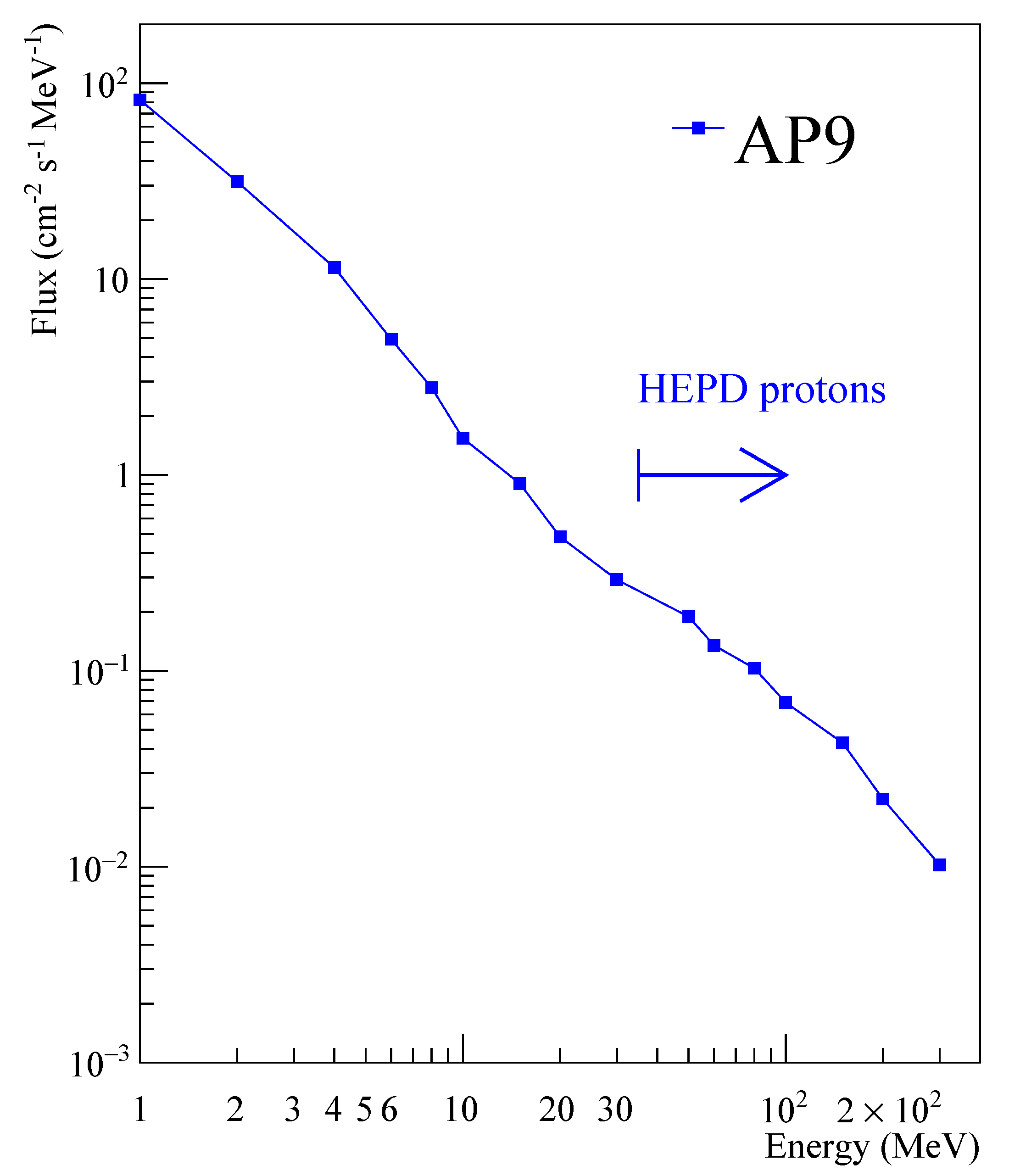
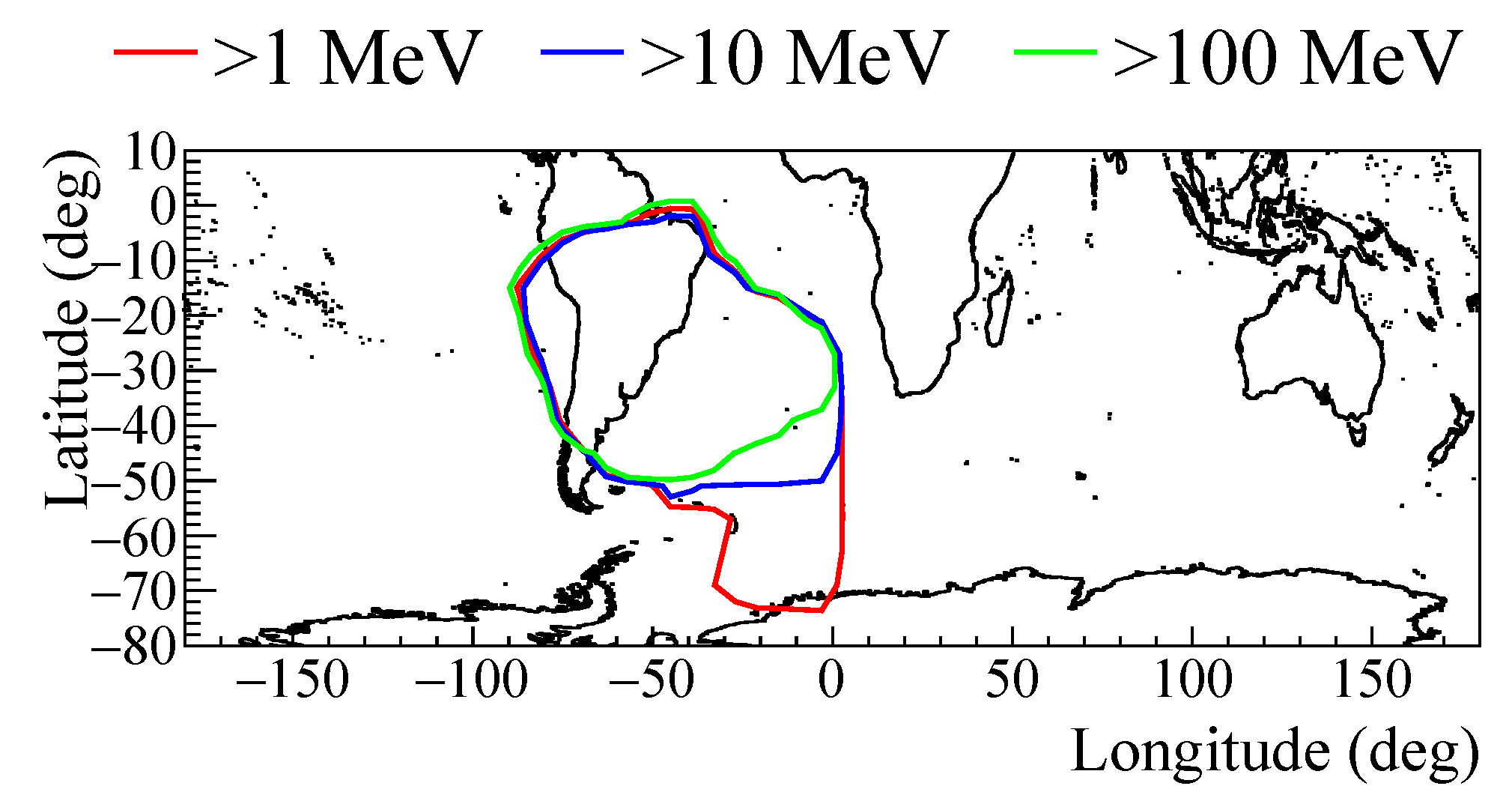
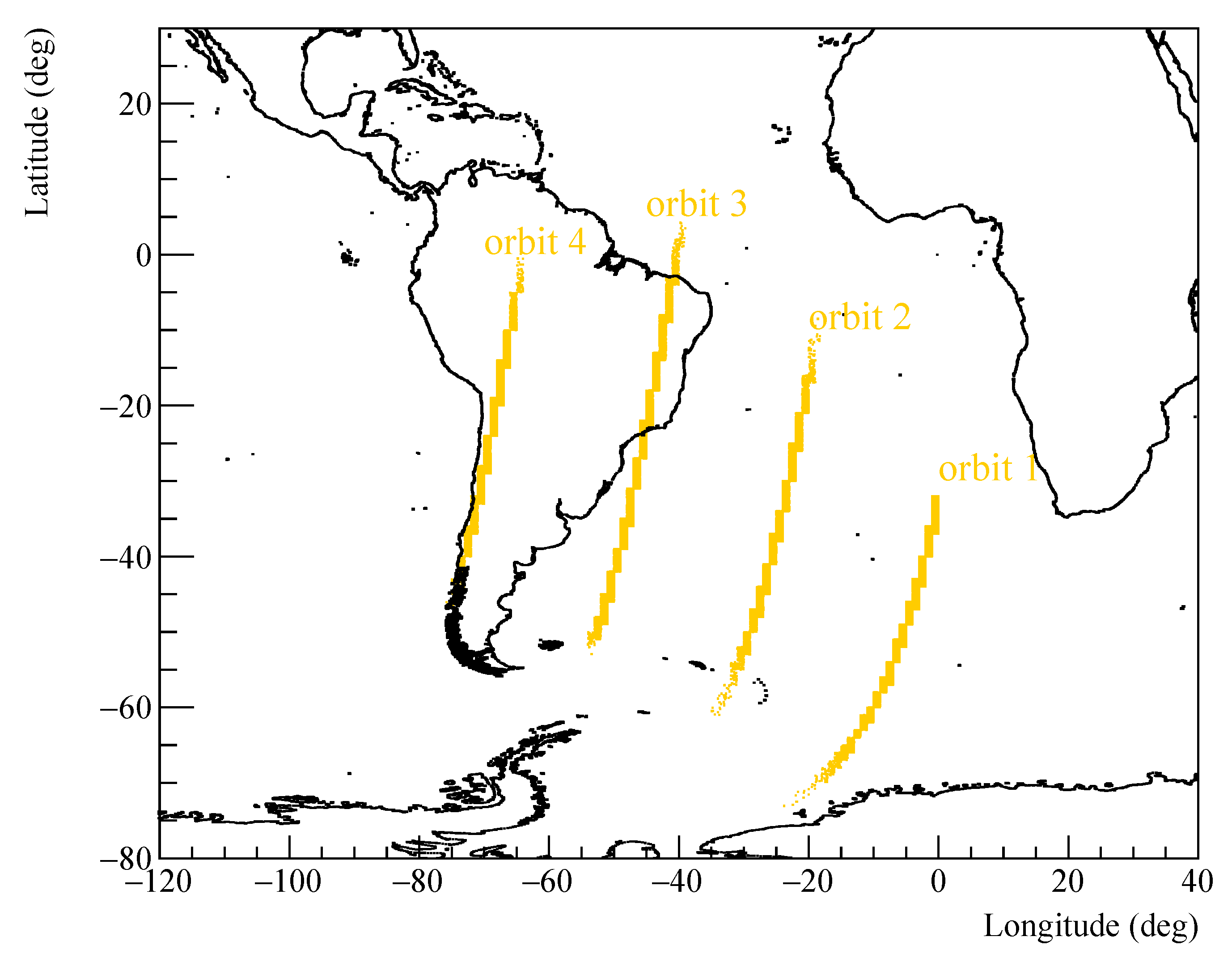
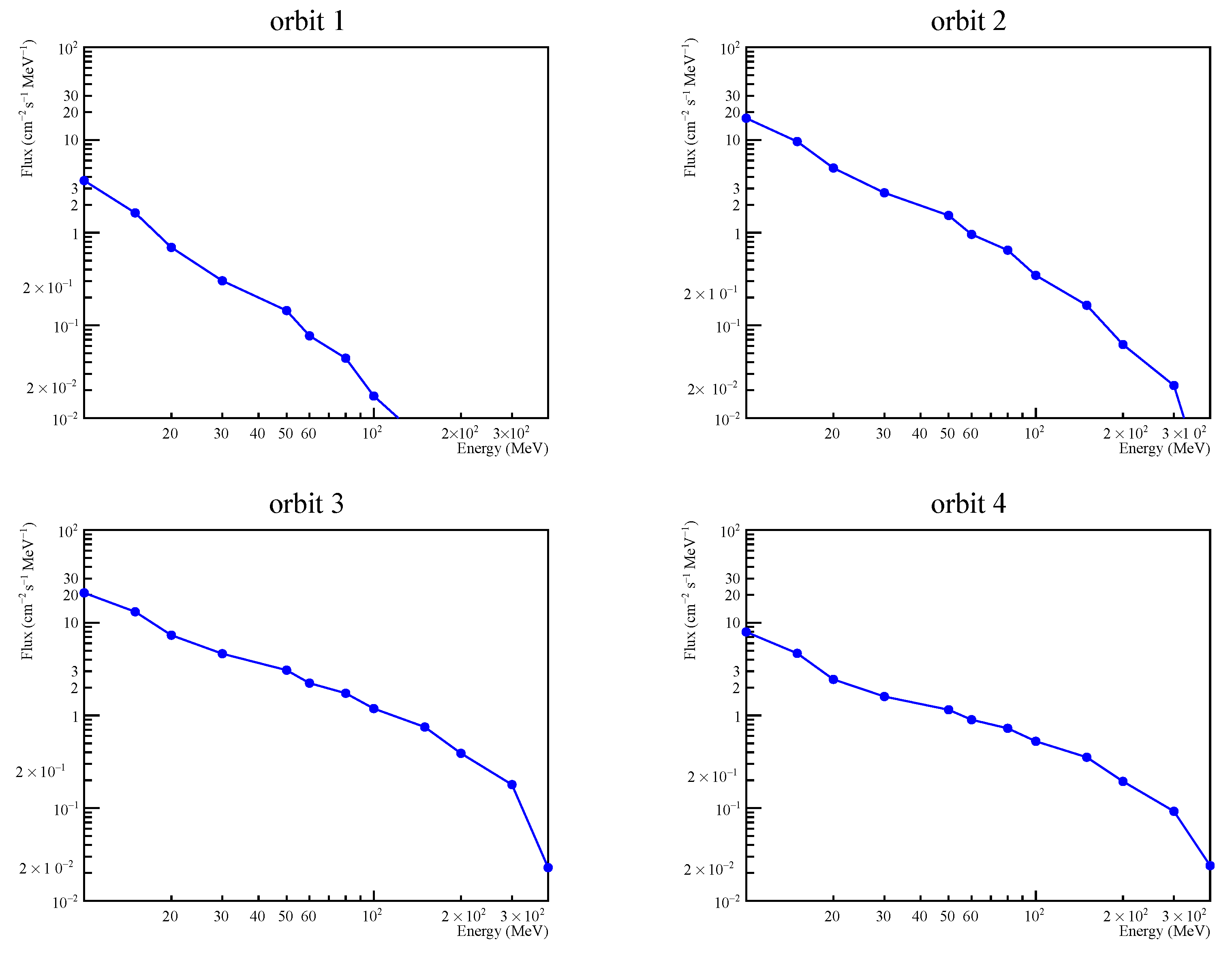
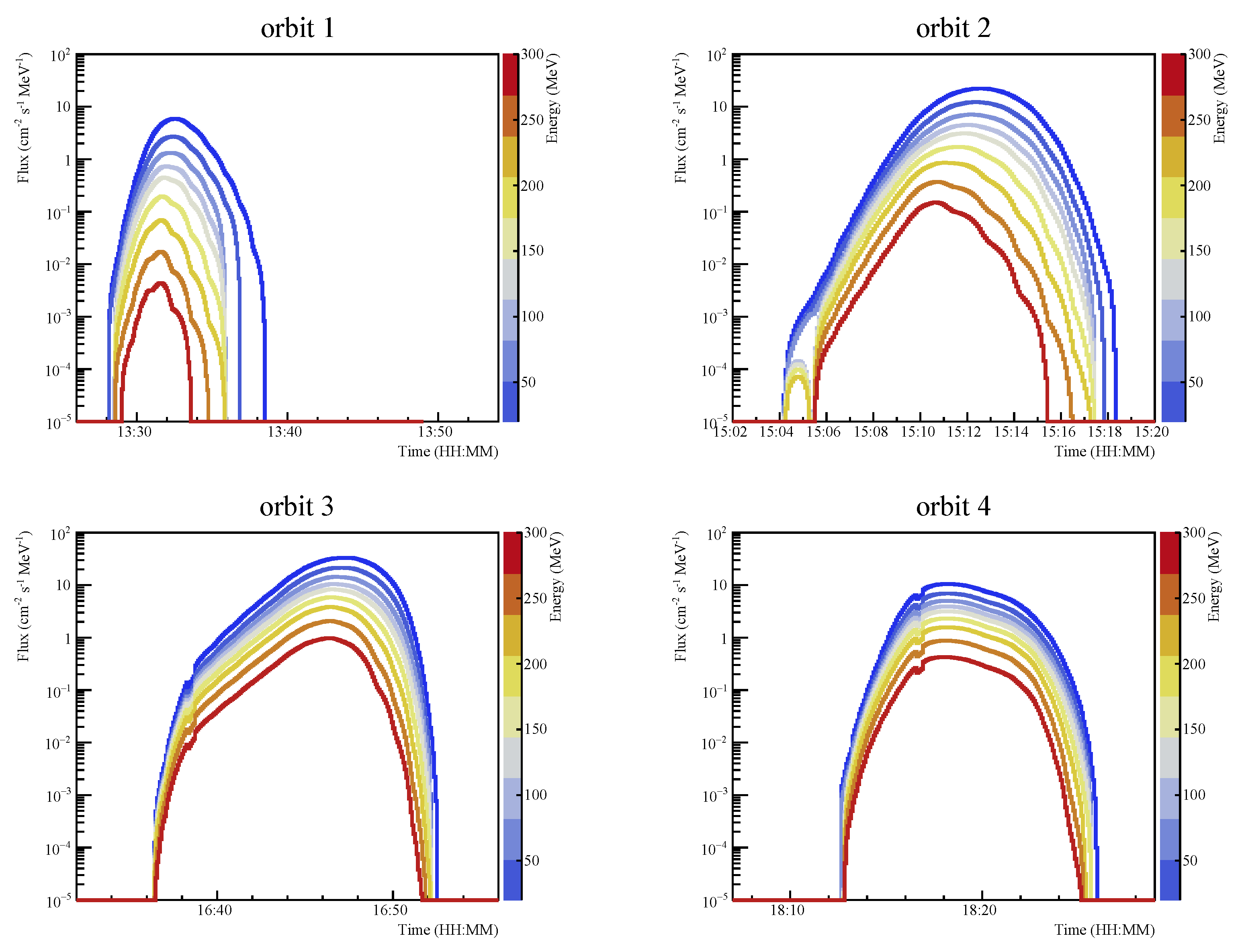
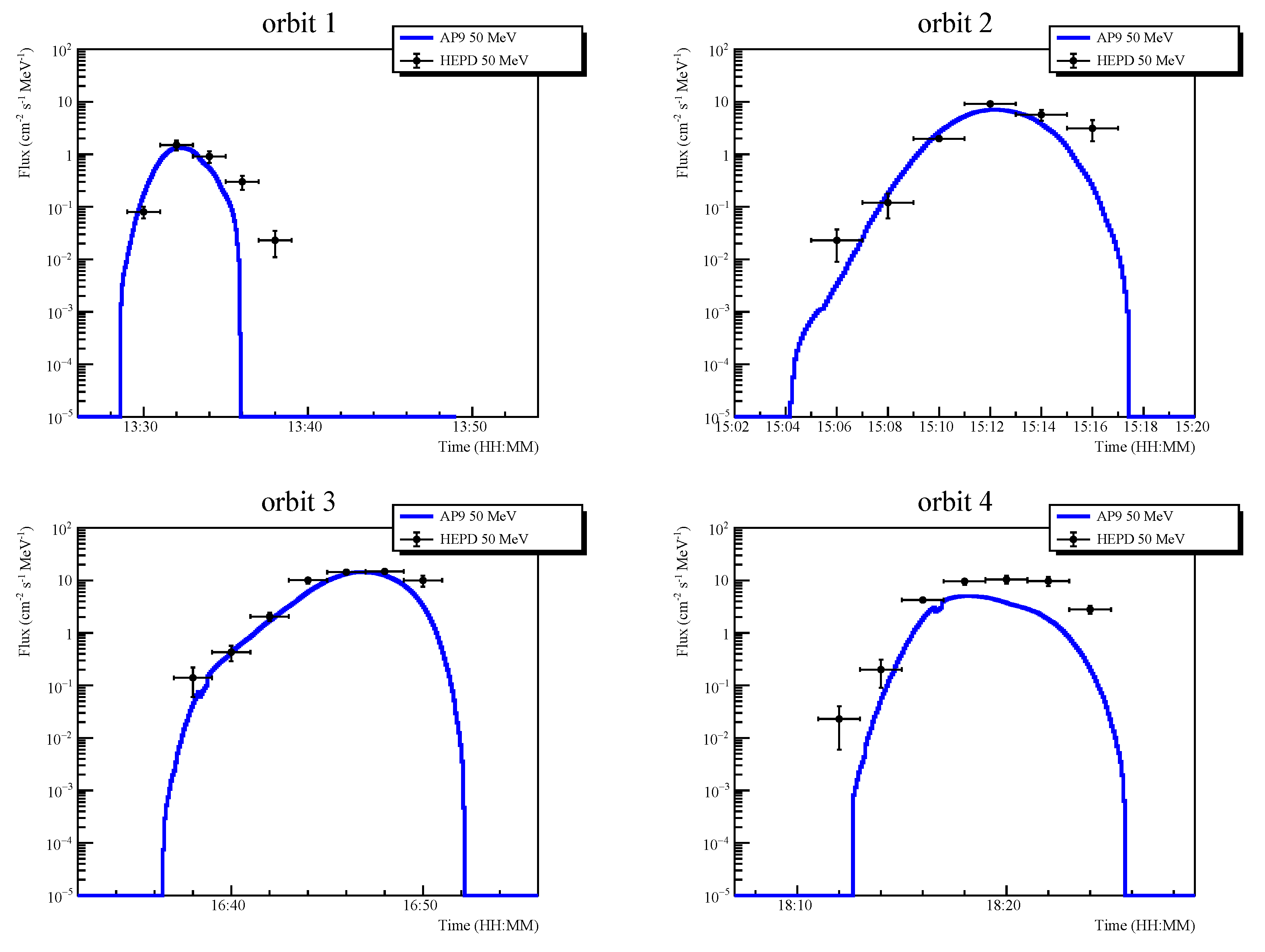
Publisher’s Note: MDPI stays neutral with regard to jurisdictional claims in published maps and institutional affiliations. |
© 2021 by the authors. Licensee MDPI, Basel, Switzerland. This article is an open access article distributed under the terms and conditions of the Creative Commons Attribution (CC BY) license (https://creativecommons.org/licenses/by/4.0/).
Share and Cite
Martucci, M.; Sparvoli, R.; Bartocci, S.; Battiston, R.; Burger, W.J.; Campana, D.; Carfora, L.; Castellini, G.; Conti, L.; Contin, A.; et al. Trapped Proton Fluxes Estimation Inside the South Atlantic Anomaly Using the NASA AE9/AP9/SPM Radiation Models along the China Seismo-Electromagnetic Satellite Orbit. Appl. Sci. 2021, 11, 3465. https://doi.org/10.3390/app11083465
Martucci M, Sparvoli R, Bartocci S, Battiston R, Burger WJ, Campana D, Carfora L, Castellini G, Conti L, Contin A, et al. Trapped Proton Fluxes Estimation Inside the South Atlantic Anomaly Using the NASA AE9/AP9/SPM Radiation Models along the China Seismo-Electromagnetic Satellite Orbit. Applied Sciences. 2021; 11(8):3465. https://doi.org/10.3390/app11083465
Chicago/Turabian StyleMartucci, Matteo, Roberta Sparvoli, Simona Bartocci, Roberto Battiston, William Jerome Burger, Donatella Campana, Luca Carfora, Guido Castellini, Livio Conti, Andrea Contin, and et al. 2021. "Trapped Proton Fluxes Estimation Inside the South Atlantic Anomaly Using the NASA AE9/AP9/SPM Radiation Models along the China Seismo-Electromagnetic Satellite Orbit" Applied Sciences 11, no. 8: 3465. https://doi.org/10.3390/app11083465
APA StyleMartucci, M., Sparvoli, R., Bartocci, S., Battiston, R., Burger, W. J., Campana, D., Carfora, L., Castellini, G., Conti, L., Contin, A., De Donato, C., De Santis, C., Follega, F. M., Iuppa, R., Lazzizzera, I., Marcelli, N., Masciantonio, G., Mergé, M., Oliva, A., ... Zuccon, P. (2021). Trapped Proton Fluxes Estimation Inside the South Atlantic Anomaly Using the NASA AE9/AP9/SPM Radiation Models along the China Seismo-Electromagnetic Satellite Orbit. Applied Sciences, 11(8), 3465. https://doi.org/10.3390/app11083465











